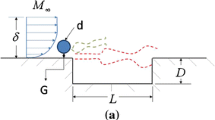Abstract
A new passive control technique of cavity-induced pressure oscillations has been investigated numerically for a supersonic two-dimensional flow over open rectangular cavities at Mac h number 1.83 at the cavity entrance. A subcavity on the front wall of the cavity covered by a flat plate was evaluated for the effectiveness of controlling cavity-induced acoustic oscillations. The results showed that sub-cavity is very effective in reducing cavity-induced pressure oscillations. The results also showed that the resultant amount of attenuation of cavity-induced pressure oscillations was dependent on the length and thickness of the flat plate, and also on the depth of the sub-cavity used as an oscillation suppressor.
Similar content being viewed by others
References
Franke, M.E., Carr, D.L., 1975, “Effect of Geometry on Open Cavity Flow-Induced Pressure Oscillations,”AIAA, pp. 75–492.
Goldberg, U. C., 1994, “Toward a Pointwise Turbulence Model for Wall-Bounded and Free Shear Flows,”Transactions of the ASME, Vol. 116.
Goldberg, U. C, 1996, “Exploring a Three-EquationR-k-ɛ Turbulence Model,”Journal of Fluids Engineering, Vol. 118.
Heiler, M., 1999, “Instationäre Phänomene in Homogen/Heterogen Kondensierenden Düsenund Turbinenströmungen, Dissertation,”Fakultät für Maschinenban, Universität Karlsruhe, Germany.
Heller, H. H., and Bliss, D. B., 1975, “The Physical Mechanism of Flow-induced Pressure Fluctuations in Cavities and Concepts for their Suppression,”AIAA, pp. 75–491, AIAA Aero-Acoustics Conf.
Jeng, Y. N., Payne, U. J., 1995, “Numerical Study of a Supersonic Open Cavity Flow and Pressure Oscillation Control,”Journal of Aircraft, Vol. 32–2.
Jorgenson, P. C. E., Loh, C. Y., 2002, “Computing Axisymmetric Jet Screech Tones Using Unstructured Grids,”AIAA, pp. 2002–3889.
Nishioka, M, Asai, T., Sakaue, S., Shirai, K., 2002, “Some Thoughts on the Mechanism of Supersonic Cavity Flow Oscillation, Part 2 A New Formula for the Oscillation Frequency,”Journal of Japan Society of Fluid Mechanics, Vol.21.
Ponton, M.K., Seiner, J.M., 1992, “The Effects of Nozzle Exit Lip Thickness on Plume Resonance.”Journal of Sound and Vibration, Vol. 154–3.
Quinn, B., 1963, “Flow in the Orifice of a Resonant Cavity,”AIAA Student Journal, Vol. 1.
Raman, G., 1997, “Cessation of Screech in Underexpanded Jets,”Journal of Fluid Mechanics, Vol. 336.
Rizzetta, D. P. and Visbal, M. R., 2003, “Large-eddy Simulation of Supersonic Cavity Flowfields Including Flow Control,”AIAA Journal, Vol. 41–8.
Roshko, A., 1955, “Some Measurements of Flow in a Rectangular Cutout,” NACA TN-3488.
Rossiter, J. E., 1964, “Wind-Tunnel Experiments on the Flow over Rectangular Cavities at Subsonic and Transonic Speeds,”Aeronautical Research Council Reports and Memoranda, No. 3438.
Sakamoto, K., Matsunaga, K., Fujii, K., Tamura, Y., 1995, “Experimental Investigation of Supersonic Internal Cavity Flows,”AIAA, pp. 95–2213.
Takakura, Y., Suzuki, T., Higashino, F., Yoshida, M., 1999, “Numerical Study on Supersonic Internal Cavity Flows: What Causes the Pressure Fluctuations?,”AIAA, pp. 99–0545.
Tarn, C. J., Orkwis, P. D., Disimile, P. J., 1996, “Algebraic Turbulence Model Simulations of Supersonic Open-Cavity Flow Physics,”AIAA Journal, Vol. 34.
Tarn, C. K. W., Block, P. J. W., 1978, “On the Tones and Pressure Oscillations Induced by Flow over Rectangular Cavities,”Journal of Fluid Mechanics, Vol. 89.
Ukeiley, L. S., Ponton, M. K., Seiner, J. M. and Jansen, B., 2004, “Suppression of Pressure Loads in Cavity Flows,”AIAA Journal, Vol 42, No. 1.
Yee, H. C, 1989, “A Class of High-resolution Explicit and Implicit Shock Capturing Methods,” NASA TM-89464.
Zhang, X., Edwards, J. A., 1989, “An Investigation of Supersonic Oscillatory Cavity Flows Driven by Thick Shear,”Aeronautical Journal, pp. 355–364.
Author information
Authors and Affiliations
Corresponding author
Rights and permissions
About this article
Cite this article
Alam, M.M., Matsuob, S., Teramotob, K. et al. A new method of controlling cavity-induced pressure oscillations using sub-cavity. J Mech Sci Technol 21, 1398 (2007). https://doi.org/10.1007/BF03177426
Received:
Revised:
Accepted:
DOI: https://doi.org/10.1007/BF03177426



